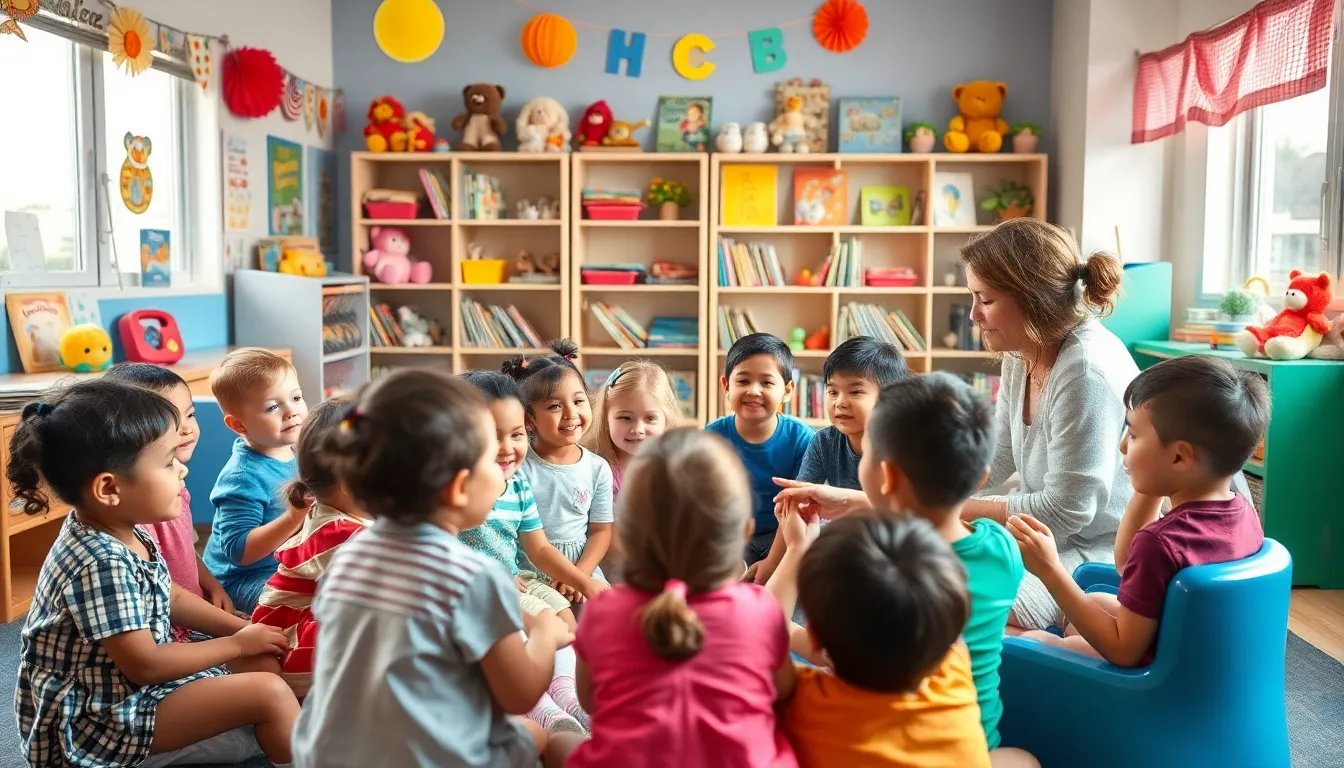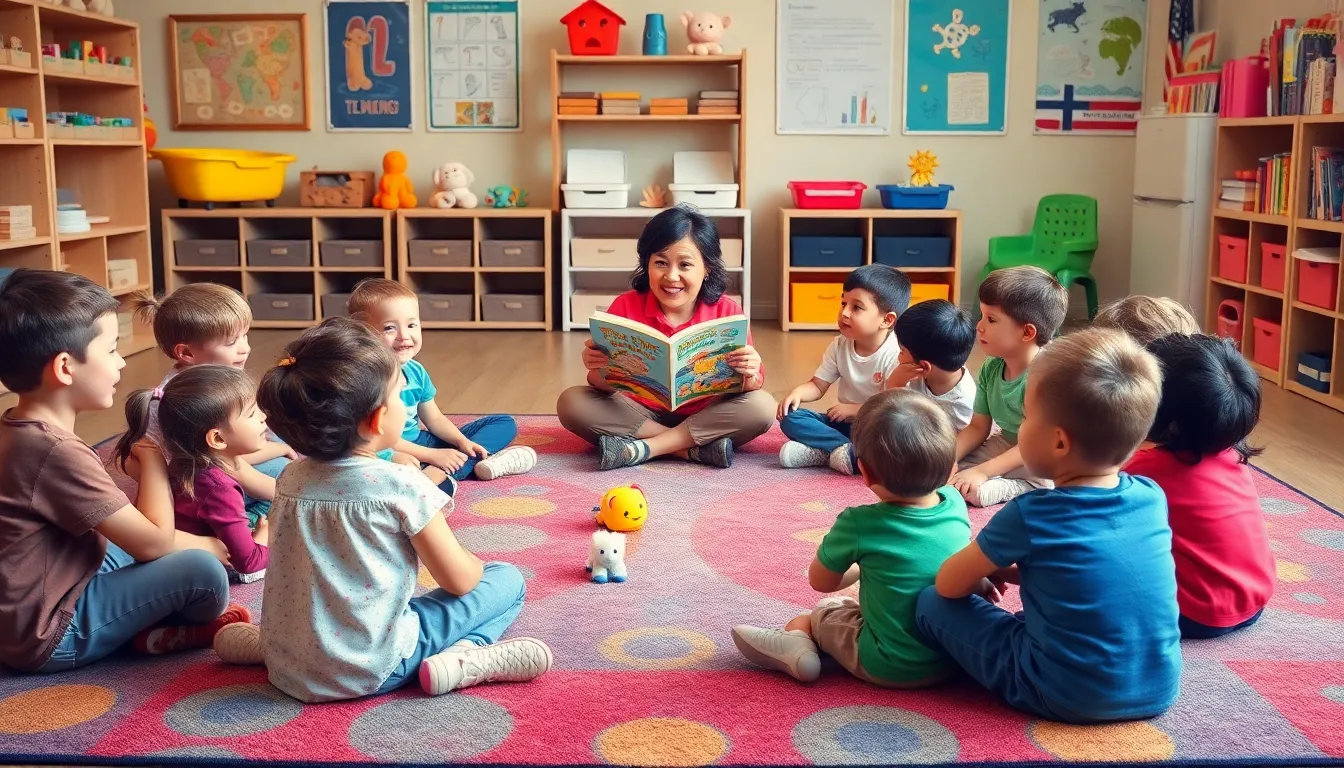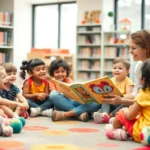Table of Contents
ToggleImagine a room filled with tiny chairs, wide-eyed children, and the enchanting sound of a storyteller weaving magic through words. Preschool storytime is more than just a few minutes of reading; it’s a gateway to imagination, creativity, and learning. It’s where little ones discover that books can be portals to far-off lands, where dragons roam and talking animals share their wisdom.
Overview of Preschool Storytime
Preschool storytime involves engaging young children with stories through reading. This interactive experience fosters a love for literature early in life. The activity doesn’t merely consist of reading; it incorporates songs, rhymes, and discussions. Children learn language skills, enhance vocabulary, and develop listening abilities during these sessions.
During storytime, children explore various literary genres, including fairy tales, folktales, and picture books. Each genre introduces unique themes and characters, sparking imagination. Effective storytelling captures attention and encourages participation, allowing children to express thoughts and feelings about the story.
Many libraries and community centers offer structured preschool storytime programs. These programs often follow a specific routine, creating predictability, which is comforting for young children. Activities may include crafts related to the story, sensory experiences, and movement games. With these added elements, children experience a holistic approach to learning.
Establishing a connection between stories and real-life experiences reinforces understanding. For instance, discussing emotions portrayed in the stories helps children relate to their feelings. This connection promotes social-emotional development and enhances empathy in young listeners.
Parents and caregivers play a significant role in preschool storytime. Their involvement encourages a home literacy environment that supports continued learning. Reading together at home complements storytime and fosters critical thinking and imagination.
Overall, preschool storytime provides crucial early learning opportunities. It lays the foundation for future academic success while nurturing a lifelong love for reading.
Benefits of Preschool Storytime


Preschool storytime offers numerous advantages for young children. Engaging in this activity stimulates cognitive skills and nurtures social abilities.
Cognitive Development
Cognitive skills flourish through storytelling. Exposure to diverse vocabulary enhances language acquisition and comprehension. Listening to narratives challenges children to follow plots and sequences, enriching memory skills. Interaction during storytime, such as asking questions, encourages critical thinking and promotes comprehension skills. Exploring various genres introduces concepts like conflict and resolution, expanding imaginative capacities. A consistent storytime routine strengthens focus and attention spans, vital for later academic success. Overall, storytelling lays the groundwork for literacy development while sparking curiosity.
Social Skills Enhancement
Social interaction during storytime cultivates essential social abilities. Children learn to share their thoughts and ideas while discussing stories with peers. Listening to others’ perspectives builds empathy and respect for different viewpoints. Participation in group activities fosters teamwork and communication skills, encouraging cooperative play. Additionally, storytelling often involves movement or interactive songs, promoting physical engagement alongside social connection. Engaging with caregivers and peers creates a supportive environment where children can express emotions. Ultimately, these interactions contribute to building lasting friendships and social confidence.
Best Practices for Conducting Storytime
Effective storytime involves specific strategies to enhance the experience for preschool children. Engaging young listeners requires thoughtful planning and creativity.
Selecting Appropriate Books
Selecting age-appropriate books is crucial for maintaining children’s interest. Books featuring vibrant illustrations and simple text often resonate well with preschoolers. Consider the children’s developmental stages and select stories that encourage participation. Rhyming books and repetitive phrases capture attention and foster interaction. Choose diverse genres to expose children to various themes and cultures, expanding their worldview. Including familiar characters can also create a sense of comfort and connection. Previewing books before the session identifies key themes and highlights interactive elements, ensuring a well-rounded storytime.
Engaging Activities and Techniques
Incorporating engaging activities enhances storytelling effectiveness. Utilizing props and visual aids, like puppets or flannel boards, adds an interactive dimension. Encouraging movement through songs and fingerplays integrates physical activity, making the experience dynamic. Asking open-ended questions invites children to share thoughts, enhancing comprehension and critical thinking. Transitioning between stories with related activities, such as crafts or games, reinforces themes and keeps energy levels high. Establishing a routine around storytime helps create predictability, allowing children to feel secure and focused. These techniques promote an engaging atmosphere that nurtures a love for reading.
Challenges in Preschool Storytime
Preschool storytime presents unique challenges that require thoughtful strategies. Addressing diverse learning styles often proves to be a significant obstacle for facilitators.
Addressing Different Learning Styles
Every child absorbs information differently. Some children may respond better to visual aids, while others might thrive through auditory or kinesthetic activities. Incorporating a mix of storytelling methods, such as using puppets, illustrations, and movement, accommodates various needs. Engaging children with songs captures attention and reinforces narratives, catering to those who enjoy music. Visual learners benefit from bright pictures, while auditory learners grasp stories better through spoken word and rhythm. Physical engagement, like acting out a scene, aids kinesthetic learners. Effectively blending these approaches enhances comprehension and keeps all children involved.
Managing Group Dynamics
Managing group dynamics can pose challenges in preschool storytime. Children often exhibit different energy levels and interests, affecting participation. Establishing clear expectations upfront encourages respect and focus among peers. Using a circle seating arrangement fosters inclusivity and allows every child to see the storyteller and each other. Facilitators may notice some children dominate the conversation, which can overshadow quieter ones. Encouraging turn-taking and allowing time for sharing promotes equitable participation. Additionally, incorporating interactive elements, such as call-and-response portions, energizes the group and maintains engagement. Tailoring activities to the group’s collective mood helps create a supportive environment for all participants.
Preschool storytime is more than just reading; it’s a vital part of early childhood development. By fostering a love for literature and encouraging imagination, it sets the stage for lifelong learning.
Through interactive storytelling and engaging activities, children not only enhance their language skills but also build social connections. The routine of storytime creates a safe space for exploration and emotional expression, nurturing empathy and understanding.
For parents and caregivers, supporting this experience at home amplifies its benefits. Together, they can cultivate a rich literacy environment that promotes critical thinking and creativity. Investing time in preschool storytime ultimately lays the groundwork for future academic success and a lasting appreciation for reading.





